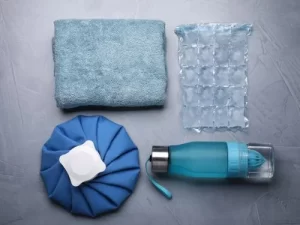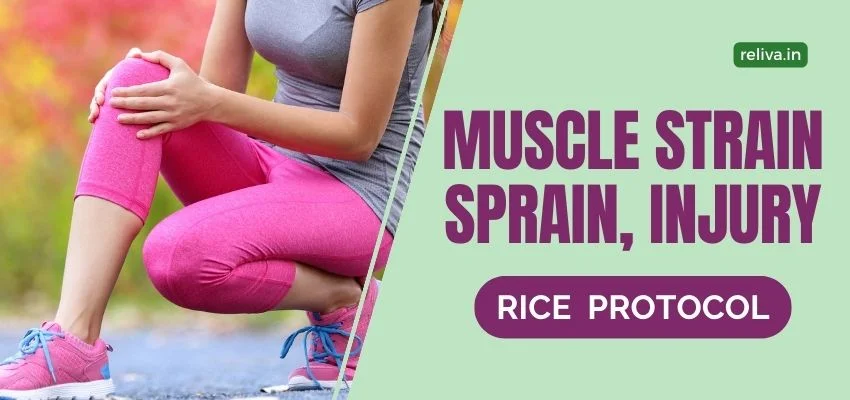Muscle Strain, Sprain & Injury: RICE
Muscle Strains or Muscle pulls often happen when you put a lot of pressure on a muscle or you push it too far, such as when lifting heavy object. Strains are more likely to happen if you haven’t warmed up first, to get blood circulating to the muscles. They’re also common for someone returning to a sport after a break or suddenly taking up rigorous exercises. Until you’ve been accurately diagnosed by a medical practitioner, RICE is usually very helpful.
Sprains are caused by injuries, such as twisting your ankle. This kind of injury is common and can happen any time you trip or fall. One lady sprained her ankle when she was crossing a pot-holed road!
Muscle pain – no matter how you describe it – “pulled muscle“, “muscle strain“, “muscle injury” or “torn tear” the end result is injury to your muscle potentially resulting in muscle spasms, pain, weakness and reduced muscle performance.
Symptoms of Strain, Sprain or Injury
You can suspect a muscle strain or injury if you experience:
- Pain
- Swelling
- Muscle tightness
- Inability to fully stretch your injured muscle
What to do for Muscle Strain?
Treatment options vary depending on the severity of your strain or tear. Until you’ve been accurately diagnosed by a medical practitioner, RICE is usually very helpful.

What is RICE Protocol ?
RICE is used as the first treatment for many muscle strains, ligament sprains, or other bruises and injuries. RICE is used immediately after an injury happens and for the first 24 to 48 hours after the injury. Rest, ice, compression, and elevation can help reduce the swelling and pain and help you heal faster.
R- REST
After a muscle, bone, or joint injury you need to take some time off from your activities to allow your body to heal. For example, if you sprained your ankle, you need to not walk around or put weight on your ankle. You should rest the injured body part until it no longer hurts to use it or put pressure on it. You should rest the injured body part for at least 1 to 2 days. If the injury is serious, you may need to see a healthcare provider.
I – ICING
Icing helps control swelling and inflammation around the injured area. Ice should be put on an injury as soon as possible as early application usually helps the injury heal faster. Never put ice directly on the skin. Wrap a bag of ice in a towel or a piece of clean cloth. If ice is not available, use a cold water bottle.
Leave the ice on for 10-15 minutes then remove it for 10 minutes so the area can warm up to room temperature. You may repeat this process two to three times. Ice helps particularly during the first 1-2 days after an injury.
C – COMPRESSION
Compression helps limit swelling to the injured area. It also provides some additional support to the injured area. You may use a doctor’s bandage, crepe bandage, a dupatta or even a piece of clothing to tie around the injured area. Be sure not to tie it too tightly. Putting it on too tight can cut off the blood supply to the area.
E – ELEVATION
Elevation is another way to help decrease swelling by using gravity. If you can, keep the injured part above the level of your heart. This helps blood go back to the heart. If you can’t raise the injured body part above the level of your heart, at least keep it parallel to the ground.
When to seek Physiotherapy Treatment for Muscle Strain, Sprain?
Returning to your routine activities or sport can be easy or complicated depending on the muscle affected. Some muscle tears such as hamstrings are notoriously difficult to get right. That’s when it is very important to seek professional assistance. Ideally your physiotherapist should undertake at least:
- an assessment of your muscle function, core stability and biomechanics to avoid injury recurrence.
- a muscle rehabilitation program that incorporates components of strength, endurance, flexibility and speed that is specific to your routine activities or chosen sport.
If you suffer a muscle tear which fails to respond after a few days or continues to niggle, please contact ReLiva Physiotherapy & Rehab for more specific advice.
In case there is bleeding or shooting pain or excessive swelling or the symptoms do not subside after a day of RICE, you should see a doctor.
Readers are advised to use their own discretion while using the contents of this article. Please go through our Disclaimer and Privacy Policy.
Related Reading:
Healthy & Positive Habits to Protect you from Stress
No time for exercise? 10 tips to get moving
Still Have Pain?
Book Physiotherapy Appointment





